#there’s are some size errors in the number 10
Explore tagged Tumblr posts
Text

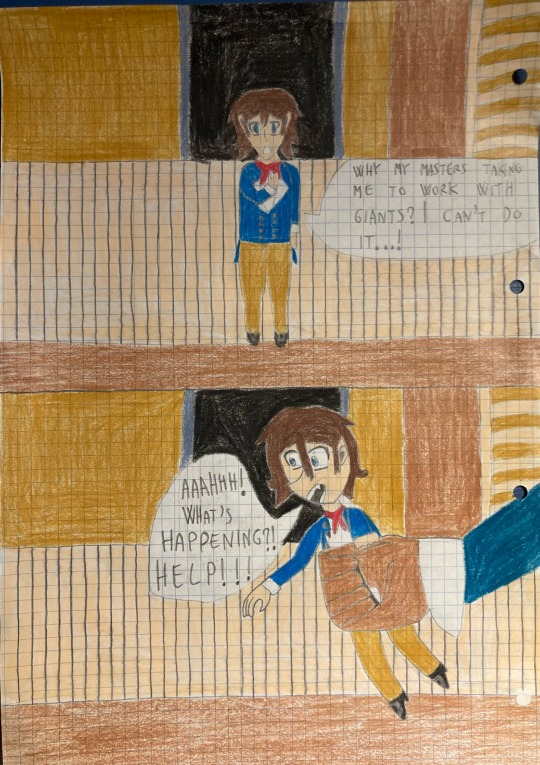

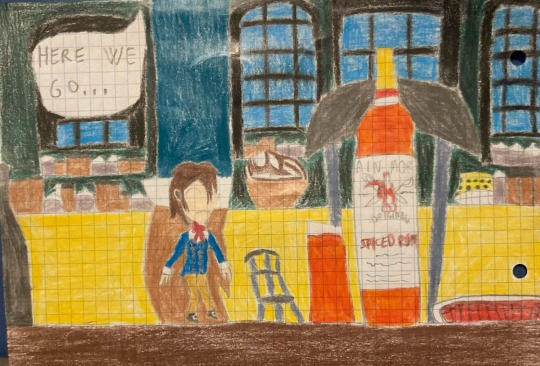



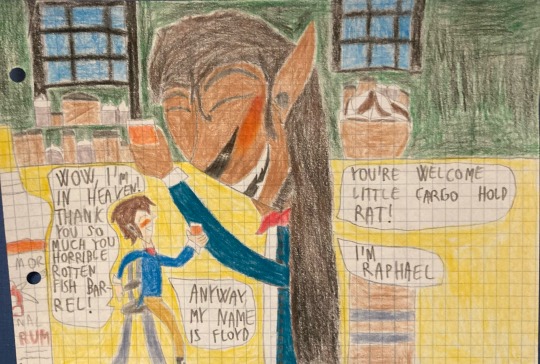
There's nothing better than a drinking time with your friends, especially when you're a sailor from 1600s and you should spend the majority of your time in the middle of the ocean.
This is how my two OC meeting for the first time. The giant Raphael and the human Floyd are from my book "The Blue Abyss and the Coloured Island" who it is setting during the English revolution. Remember that Floyd is not only the main character of my book but is also my personal fear play oc for vore scenarios, and we will have may fun with that. 😈
Unfortunately there's nothing steampunk in there. This is when they meeting each other so they are not yet powerful steampunk wizards.
This is a little comic so clic on every photo for a better quality. I hope you enjoy it. Reblog if you like it. ❤️
#there’s are some size errors in the number 10#Raphael is a pure blood giant#he should be able to swallow three humans alive#and why Floyd have fangs?#because in this world humans are magical creatures#they have elemental control and shape shifting type magic#so humans also have fangs#but unlike giants fangs humans have them only when they fell strong emotions#g/t community#giant/tiny#g/t#giant and tiny#giant tiny#g/t mention#g/t sfw#g/t stuff#g/t fandom#g/t art#g/t fluff#g/t ocs#my art#my artwork#oc art#my oc stuff#my oc art#g/t comic#g/t concept#g/t interaction
6 notes
·
View notes
Text
First Quilt!
It has been a lot of fun and a lot of trial and error but it's done!!!




It's roughly 1.20 x 1.20m (which is a number of feet I can't be bothered to look up but let's say it's about child sized and it'll be great to chill on the couch).
I want to thank @langdon813 who I've never talked to (sorry if you hate being tagged) but whose gorgeous Drunkard path quilts made me wanna do it too :)
I had never done any quilting before (but I did sew), so here's what I've learned, if any beginner is interested in jumping off the deep end the way I did and wants advice from someone who has freshly acquired experience but will also not use any confusing technical terms (with pictures!) :
Fabric picking : so most advice I read was to go for pre-selected bundles of fabric that already go together, but I'm contrary and like to do my own thing so I used wax fabric (the blue ones on top the pile) I had laying around, which I strongly recommend: it's very easy to cut due to it being waxed, and I added a few fat squares from the shop, plus I also had the orange and blue floral and I based the coulour scheme on it. One thing that's true is it would have been easier to work with fabric of the same thickness, and the floral was givne to me by my ma who got in on trip to Thailand and it was alot thinner than the rest which didn't help.

Cutting: I got a rotary cutter for the occasion and it's great! Do not maybe push too hard on it and give yourself nerve damage the way I did (temporary but still), it's actually ery sharp and easy to use, so long as your template doesn't slip you're fine
Piecing :Yes you can do curved piecing even if you have zero experience, you just gotta make a template and
pin it a lot.
1/4 inch margins is the standard so I rolled with it because I don't like converting, but when you're strictly metric it is kind of annoying but doable because my machine does have a 1/4 inch mark and if you stick a length of tape along it it's pretty easy to follow, even for curved piecing.
Layout: At some point you've got to decide the layout is done, because I've re-arranged the blocks at least 6 times and it's a very good way to go insane. (For rough reference, my plan was to have no repeat fabrics in any of the circle-in-a-square blocks, and I only made one mistake which I clocked too late to change)

Chain piecing!! Meaning you pile your blocks together in a specific order (that I personnaly wrote straight up on each piece with a very sophisticated letter/numbers down/across system) and then just sew them together in a line without having to cut the thread between each pair. Looks a little like a fanion banner and at some point it feels like you'll be forever tangled into it but then it's magic :) It's not that hard actually and will save you a lot of time + there's a lot of online tutorials you can use.
Basting! (which it took me while to understand is the part where you attach the backing, the fluff and the quilt top together) : you need more safety pins. Safety pins will save you from the wrinkles and the unfortunate oopsies of realising you've caught your backing double folded into your quilting stitch, which I did a good three times and was not fun to undo. Also, I forgot to tape the backing to the floor and it probably would have helped with the wrinkling...
Backing : I used an old linen table cloth I got for 10€ at a charity shop, and I've still got about 2/3 of it left, so I recommend that, it's sturdy but soft enough, doesn't thread easily and can be washed at very high temps, if that's a thing you do.
Quilting! Well, my machine came with a quilting foot for free motion quilting (which means you're the one moving the fabric along in whichever direction and you can sort of draw with your stitches) and it seemed fun so I did that, and here's what I learned : curves are hard but doable, also my machine doesn't like to go back (kept skipping sitiches for some reason) so it involves a lot of shifting the quilt around, which isn't easy considering the bulk. And also, drawing the quilting pattern you want so you can follow it while quilting actually does help, I used an iron/heat-erasable pen and it worked just fine. Check your stitch tension, mine was too loose and I realised too late so there's spots where I could pull on the thread and it looped, had to stitch back over that.
Quilitng pattern : I wasn't sure what to do, supposedly your batting (aka: the fluff) comes with instructions on how tight you should quilt to avoid it coming apart through use but I got mine cut at the fabric shop and forgot to ask so I just rolled with a rough 10cm maximum distance in between stitching lines but tried to do less in most places. According to many blogs : the tighter your lines the stiffer your quilt, so I kept it loose for comfort. (Picture is halfway done, I added a smaller square/circle inside each square/circle and if you look at it you'll see it's actually diagonal lines form one end of the fabric to the other.)

Binding is boring, and there's nothing to it. I got a length of pre-cut bias binding, machine-sewed it front to front to the quilt top side of the quilt and the folded it back and secured it by hand to the back with a ladder stitch. Took me roughly and entire rewatch of the Last Of Us. There's a trick to doing the corners that's fairly simple but I've lost the tutorial...
Overall : I got myself a quilting book with techinques and such and it helped, but there's a ton of stuff online, and once you get over the very Christian American mum vibe of most of the blogs, it's all very helpful (and gorgeous!) (no offense meant to Christian American mums, it's just a bit of a culture shock from where I'm standing).
#quilting#quilters of tumblr#quiltblr#quilt tutorial#quilt pattern#quilt#drunkard path#home sewing#sewing#sewing project#beginner's quilt#beginner quilting
184 notes
·
View notes
Text
Quilt Portrait Process
This may be of no interest to most of you, but with all the comments I got on my Impala portraits, I thought this would be of interest to some of you.
Original Photo

This is the original photo I used--it's of a fan car ("Night Moves") that was at Denver con 2022. What a great photo!
Posterize
In Photoshop, I posterize the photo to get chunkier blocks of color. I just play with the number of levels until I get a good representation.

Draw Lines
I place the posterized image in Illustrator (reversed) and then go to town drawing lines. The rule for pieced quilting is that every line you draw must go all the way until it hits another line. So for the first couple of lines, they go all the way from one end of the photo to the other.
I just keep drawing until I get something like this.

Paint the Pieces with Color
I bring the outlines into Photoshop so I can paint each individual piece with a solid color that will match the (future) fabric. Sometimes posterizing can result in dark colors, so you have some creative liberty to make changes. Note that these are still just screen colors; the actual fabric will differ again.
Outlines:

Colored:

Number the Sewing Order
Paper piecing means that you sew through the paper and fabric. That way, you can be sure to place your seam perfectly.
Generally, in quilting, you want to sew a seam from one end to the other without running into any already sewn seams. For a traditional patchwork, this means you would sew 10 blocks, then sew a row of 5 blocks, and then sew another row of 5 blocks onto the first row.
Paper piecing is the same, but because no "block" is repeated, it's an exercise to determine the sewing order of each block, and then the sewing order of the blocks to each other.
A quilt like the Impala has a few hundred blocks of 1-15 pieces of fabric each. Within each block, the sewn size is near perfect. But sewing the blocks to each other introduces a lot of variability: the seams can be wider or narrower, or the alignment can be off. That's why the actual quilt looks "wonky" compared to the pattern. It's just not possible--for me--to get it perfect. If I didn't work so small, it would be easier.
Back in Illustrator:

You can see that the black lines are pieces within a block. The red lines are blocks. And the green lines are sections of blocks. It all needs to be sewn in order. I will make small changes to the sewing lines at this stage to "make it sewable."
Printing
Because printers aren't the best at replicating onscreen colors exactly (good luck telling the difference between black and dark purple), I have to recolor it to "printable" colors and then do a swatch concordance.

The bright green on the left actually represents lavender.
I print the pattern out on vellum, which is more durable than paper. Since this is 17" x 17", I will print out overlapping 8 1/2" x 11" sheets. Illustrator has a good printing function, so you can print the exact area you want.
Pick Fabric
I have collected a ridiculous amount of fabric. These want solids for the most part. Sometimes it's a challenge getting 5 shades of blue, or 6 beiges for their faces, so sometimes, I make color errors that I don't discover until later. Painful mistake. The above pattern uses 25 colors, but some of the faces use around 40.
Sew
This is a really challenging project. It would be easier if it were bigger! The pieces are so small, and when you start sewing blocks together, the layers get to be ridiculously thick with all the seam allowances. It's a true challenge to feed through the machine. Use a small stitch length; use a good machine with dual feed (Bernina!!! or maybe Pfaff).
Check out the back side of the previous Impala quilt.

I pull out the paper as I go, otherwise it will get accidentally sewn in.
Finishing
I don't do complicated quilting here. The piecing is what's on show! I embroidered the Chevrolet and the license plate lettering. Some things are really too small to piece.

Original Photo Again:

Conclusion
I think anyone could do this, in theory. It takes a lot of patience. And your sewing machine needs to be quality. And it helps to know how to use Photoshop and Illustrator. And you need to "get it" when numbering the pattern, in a mathematical way. And it's helpful owning all the fabric.
If you do try it, make a larger quilt; this size with this level of detail is crazy making.
Check out all my supernatural quilts on Instagram! https://www.instagram.com/catnipster69/
149 notes
·
View notes
Text
i have seen a lot of posts about the merch quality so i thought this could be interesting. although with a lot of different items i guess there might be some variance in quality (like clothes vs calendar?) so coming up with one number might be tricky if you own different items
i was thinking quality in terms of material but you can also include opinions on design etc. accurate sizing too? how well things wash? any print errors on calendars? i haven’t bought dnp merch since 2015 lol so i am very interested! the merch i got back then was quite good quality
20 notes
·
View notes
Text
Okay this is actually a partial reply to another post
but my reply got so long i think tumblr literally cant cope LMAO so (context the Amity park perception filter thread with @kaidatheghostdragon which i will edit a link into after posting (X) Edit: the context link is now attached)
Honestly they might not CRASH crash the economy but I honestly think they could do some serious damage. At the very least if Amity is going to start essentially printing USD with these cards to get infrastructure and the like set up the inflation within the town is going to go crazy and they might just need a new currency. I think it's also determined by how LARGE you consider Amity to be. As I've always seen it described as a small town I've always envisioned it to have a population of around 10,000 people. AS IT TURNS OUT the wiki describes it as 'Amity Park is depicted as a moderately large urban city, reminiscent of Chicago, San Francisco, and/or Philadelphia' WHICH IS WAY LARGER THAN I IMAGINED. I don't know SHIT about American cities or their layouts apart from the fact that Everything Is Squares and also apparently the junctions are death(? Apparently America doesn't have roundabouts??? Bro??? I don't know if that was a Simpsons gag but I think about it maybe half as often as I use roundabouts), BUT the point is that google says those cities are somewhere around 800,000 to 2.6 million.
Honestly I think those are weird numbers because those are enough of a range to not be at all considered the same size imo but we'll take Philadelphia as our base bc that's the one in the middle at 1.5 million. In "Amity Park's" population statistics (X) if you take everyone from 20-44 (we're pretending people under 20 can't get one bc apparently 13 year olds can get them with special permissions and that fills me with a special kind of anguish to have learned) but if you take everyone from 20-44 that population totals something like 613,028.
We'll give an error margin of 10% to account for people who are auto disqualified for whatever reason and between that error margin and the people I'm ignoring I think it's realistic to assume you could get 551,726 people credit cards. Unlimited ones? maybe not. But look me in the eyes and tell me if Sam Manson was told 'We can fix the public infrastructure that's damaging the environment and cause serious damage to predatory lending companies' She would not use her families wealth to be backing people as some kind of collateral/co-signer to get OBSCENLEY high credit cards SO FAST. That's to say nothing of if Tucker and the Other Nerds decide it's actually completely fine for them to hack into these companies and auto approve all these credit cards. Like the towns in dire straights so why not? It's unfortunately a pretty human tendency to see the people you care about in trouble and decide you're willing to throw literally anyone and everyone under the bus so I can see him/them doing it.
So. 551,726 people, with theoretically unlimited money to spend. CONSERVATIVELY if they racked up $500,000 USD on each card, the amount of money spent by Amity would end up being $275,863,000,000 or $275.8 BILLION Now the GDP of the USA is $25.44 Trillion, which looks like $25,440,000,000,000 so it's not a LOT in the grand scheme of things but it is just over 1%, I'm not going to pretend I know what that does economically to the entire USA but consider that Beer sales in the USA accounted for $106 billion in 2022, and that amity would potentially be generating nearly three times that. (X) I have just gone on a fucking TANGENT about the economy in this silly fun times thread of ours so I apologise I will try and sum up very quickly why I think they could spend so much so quickly. Philadelphia has a total of 37 hospitals. They built a new one sometime around 2021 to the tune of $1.6 billion (X) If Amity built a new hospital for liminality care and a few new ones Just Because They Realised They Can, say they build ten new hospitals, which is a VERY LARGE amount of new hospitals to build on workforce Alone, but they probably have tireless ghost workers who are probably obsessed with construction and regular living workers who want to be paid in the times before everyone had acclimated to the ghosts properly. Split among 551,726 people that's actually a fairly reasonable $28,999.90, which, hilariously, is actually just in and around the average limit to credit cards. So they wouldn't even need Sam or Tucker to mess with credit cards yet (X) Averages typically suck as a way of measuring stuff but this isn't a Real Life Government Project so I'm willing to call that acceptable. So if it's only $30k for ten hospitals why the hell am I citing a fat $500k each? Luxury Shit. A few luxury cars and some big name watches and you've blown through that $500k no problem. That's to say nothing of all the REST of the infrastructure that needs fixing - the roads, the schools, the libraries, the replacement materials for the transport system - hell building the APDC is going to probably be another billion dollar project if they want two portals large enough to get what is probably multilane traffic through in regards to transport. Sure the cars won't be useful for long maybe but that's just one example. Jewellery, coats - hell designer shoes and collector nonsense can go for STUPID amounts and as people who are desperate to outpace their neighbours in Cool Stuff They Own realise that their neighbours are capable of getting all the same crap they are? people are either going to stop caring or they're going to start buying some Really Obscure Shit. For the others who just wanted to buy pretty things? There's literally no reason to stop. Amity might have to limit the amount of crap people can get shipped in per week/impose serious shipping tariffs just to make sure the new FTL supply chain doesn't collapse because people are determined to get their new Cashmere and Mohair coats with Gold Embroidery or what the hell ever on next day delivery. Honestly in this scenario the cards over time thing probably doesn't matter because I'm pretty sure the Amity expenditure would DESTROY the lending company, which might then actually be the thing to get Amity rediscovered or maybe they space all these buildings out over time so they keep living the sweet life.
54 notes
·
View notes
Text
Picking up from Rick & Steve.
So that's part of it. I kept coming back to what it'd be like to live in the real world where some men are "G+" and can take the Goliath Serum.
Here are the general rules I was thinking of, then. Nothing was locked in, I just liked how it was starting to lay out.
Only men can be Goliaths. They don't have to be gay, but that is what I'm interested in writing about.
You know if you're G+ or not. The actual amount of people who are G+ is really small, but I didn't decide what it is.
Everyone starts out negative. The gene for this just shows up in life somewhere along the way...but not everyone gets it. There's no predicting it. It's related to epigenetics. If you're going to be G+ it'll happen after 25YO up to about 45YO. Otherwise, it's just not in your cards.
Being G+ means you can take the serum and grow. You do have to, and nothing bad happens to you if you don't. Taking the serum before that gene has expressed itself causes no change. You might as well have had a beer. Nobody gets the serum accidentally, it's not exactly over the counter.
Being G+ means you get a score, and that's how big/tall you'll be after you finish growing. There is an increasing margin of error as the "Goliath Score" goes up. Scores near 8 feet tall could be off by up to 6 inches one way or another. Scores at 10 feet and over could be off by up to a foot in either direction. There's just too much individual variation to be sure about it.
The biggest Goliath on record is just over 12' tall. The shortest is in the low 7' range. Things are staying to a very very big human scale, but a human scale. More Goliaths are in the 7-9 foot range than over, but I haven't set anything into numbers. It's just a feature of how the world is.
After treatment, Goliaths transform over time. The rate is roughly about an inch a month, and 20# a month, until you get to your size. Your body has a lot of plasticity in this time - you could work to get hugely fat, morphedly muscled, or anything else that's doable. People plan for and train and eat for a particular result.
This whole Goliath thing popped up sometime in the last roughly 25 years, and gained some traction. Buildings, houses, businesses... everything in the world... isn't built for these guys. Some of them, up to 8 feet, can make do in regular houses. But the BIG guys, 10+ feet tall? That's different. He isn't fitting in your house without crawling.
Just remember, all this means that a guy who goes from six feet to twelve feet takes about six years to do it. (That's important later.)
Okay, let's pretend those are the rules.
What does the world look like?
What are the relationships like? How do they change?
What happens when your slight smooth twink husband finds out he can be a nine foot muscle giant. You think that would be so damn hot...but he hates the idea. What happens then?
Your brother always had your dad's love in the family because bro was the straight football jock, the big guy. You're the gay bookish accountant. Tonight is Christmas dinner at the family home. There'll probably be a moment where they get into football, and maybe put you down for not playing it. Just before you walked in you had an email that reported your G+ score at 8.5. You weren't even thinking of it on the drive up, and sure haven't made a decision, it was a total lark to even get the test. But tonight... this night... your jock brother will say the thing that sets your decision into stone.
You found out why you felt like you didn't fit in! You were so much bigger on the inside! Now you could let it out and show everyone!
You've been the built gay gym guy your whole life. You lack for almost nothing - sex, travel, success, friends, anything anyone could say they might want. Genuinely a nice good lucky guy. You just found out you have a solid G+ score of 11. You even have a friend or two who are that huge. When they visit, you guys are always in the backyard hanging out because your beloved home is a 1900 craftsman conversion you painstakingly did all the work on for over 12 years. And...the ceilings that go right up to 9 feet tall. The place you lived, loved, labored all this time and with your own hands, and now you can't fit inside? Will that dream become a dollhouse to your new body?
And yes, we'll see the other guys: the ones who are just hot, hot, hot men, big, small, in between, and we are going to get into their fun sex lives, strength, power, and more. Not EVERYTHING is complicated!
So, now, about these men:
Who knows what they'll decide to do?
Who knows what they'll get up to?
I'd love to know...wouldn't you?
Good. Because I already wrote a book about it. We'll get to that soon.
8 notes
·
View notes
Text
From the beginning | Previously | Coin standings | 50/57 | 30/30

You pick up the phone and DIAL A NUMBER, heading to what ought to be the holy tower.
Error: No codec found for undescribed audio input "hawk_3_0075.soul". Converting to byte array and delegating to receiving device for validation. Error: No codec found for undescribed audio input "dove_2_0060.soul". Converting to byte array and delegating to receiving device for validation. Error: No codec found for incoming byte array. Raw data "hawk_3_0075.souldove_2_0060.soul" stored in message buffer. Error: Message buffer overflow. Discarding excess message data.
The sensation is no more pleasant than last time. You feel as though you've been squeezed through a tube of toothpaste, and you're seriously disoriented when you come out the other end, in...

Hmmmmm! Okay! So, uh, maybe you've come out through the phone in the middle of a sauna, because the building is slightly on fir𝖾. Only like, slightly, though, right? How flammable could it be? In reality it's all steel and glass, and here it's like, stonemasonry. Was it the RAT PECS? Maybe it was the RAT PECS.
Oh gosh okay no yeah the building is pretty on-fire. You're not sure how that happened but it's definitely time to grab some EERIE HURT-FIXINGS off the wall and start spraying your way to the BIT COIN MINER.
Whew. Okay. You find the coin miner at the bottom of a pile of foam after extinguishing the largest of the blazes you could find, and unplug that thing tout de suite, claiming 10 Coin from the wreckage of... no, actually, it's completely intact. They build those things to last, apparently! You should... probably iɴstall it somewhere this will be less of a problem, though.
Heading downstairs, you find the shop is mostly unchanged:
RELINER STAFF (30)
HACK IN NIL (22)
OW, PANIC! ICE FISTS! (12)
A COUCH FÉVER (10)
BILATERAL SIZINGS (9)
A SNARE WORM (3)
NOBLE BELT TUT (2)
STOPWATCH FARE (2)
BEAT USER (1)
With no sign of your daughter or a way home down in the subterranean graveyard, you've got to come up with another plan. N๏w what?
Since the building was recently on fire, there's NO LIMP ICE YONDER. Granted, there wasn't any before, either, because ice is typically rigid.
If wishes were horses, beggars would ride. But then some guy named Tom, hungry enough to eat a horse, would eat them all, and IF WISHES WERE ALL IN TOM you'd have problems.
Hey, she's holding that exciting event! HER TRITIUM FROG-OFF, where frogs equipped with gear using radioactive hydrogen isotopes battle to the death! That sounds fun.
There's some luxury cars here, but they seem like they were built by extraterrestrials- these UN-HANDY ALIEN BUICKS weren't intended for human use.
Continued | 48/55 | 29/29
14 notes
·
View notes
Text
A primer on Margin of Error (MOE) and what this means for the polls as election day gets closer
A new poll from Selzer came out of Iowa today showing Kamala +3 for the state. This is significant because 1. The past few elections have gone to Trump; 2. This pollster has called Iowa's vote in every state since 2012, often coming remarkably close to actual numbers.
However, there's been some confusion as to how Trump still could get more votes in Iowa without the pollster necessarily being wrong (this has been a point of confusion since 2016). Essentially, this relies on a concept called margin of error. In this instance, the MOE was 3.
Essentially, the margin of error goes both ways; Kamala could be three points lower or higher than this poll predicts while Trump could also be three points lower or higher. If you combine the worst case scenarios suggested by the latest Selzer polls, you could be looking at Trump actually being up 3; however, even this is still INCREDIBLE news for the dems.
A longer-winded explanation on margin of error and confidence intervals: for a confidence interval, you are trying to find a range that, if you repeated your trial/experiment (in this case, elections), the result would be in this range (x) percent of times (usually, this is set at 95%). Suppose you were growing flowers, and wanted to know how many pink roses you could expect; suppose we also calculated the proportion of pink flowers in our sample to be 1/4; 25 out of a total of 100 roses grown during the experiment.
The margin of error = Z value (more on that in a minute) times the square root of ([p times (1-p)]/n), where p = the sample proportion, n is your sample size, and the Z value is a way of measuring how far a value is from its population mean. The Z-score is standardized, and when your alpha is 0.05 (that is, your desired CI is 95%), it will equal 1.96.
Our margin of error would then equal 1.96 * √(.25[1-.25]/100), or approximately 0.0845. Therefore, our margin of error is 8.45%. We can therefore conclude that when replicating our study of 100 roses, there will be between 16.55 and 33.45 pink roses 95% of the time, as the MOE is added and subtracted to both ends of your number.
To tie this back in to the election: if 47% of voters in this poll are voting for Kamala, with an MOE of 3, and we assume a representative sample (no sampling error), that means she can expect to win between 44% and 50% of votes in Iowa 95% of the time. Similarly, Trump can expect between 41 and 47% of votes 95% of the time. Thus, while the pollster was fairly confident in their Kamala+3 result, it could be as high as Kamala +9 or as low as Trump +3.
This is also why polls can have the wrong result but not be bad/flawed polls! If they were still within their margin of error, their sample was still very likely to have been a representative one, and their poll was just "unlucky", so to speak. if they call for a candidate to win by 5, their MOE is 6, and the other candidate wins by 1, they are still within their MOE, and their methodology wasn't inherently flawed. On the other hand, if they called for a candidate to win by 10, and their opponent won by 10, with an MOE of 3, there were likely problems that could range from flawed methodology to sampling error.
In short: it's not about the absolute result (Dems/Repubs winning) and is instead about how close the win was to what was predicted.
Now, and this can't be stressed enough: fuck the polls. Don't listen to them. Vote like you're behind (with urgency) but also well within striking distance (not hopeless). Make a plan to vote and bring as many friends as you can to the polls if you haven't already voted. Our democracy depends on it.
12 notes
·
View notes
Text
PACKERS AND PACKING INFORMATION AND REVIEWS:
Cw: prosthetic male genitalia/penises for informational purposes only 
I’m going to start this by first introducing myself so hello I’m Jackson I’m a plus size ftm trans teenager and I’m going to go over the best and easiest way to pack as a trans dude
You may be asking what a packer is? Well a packer is a gender affirming tool that creates or mimics a bulge or a penis which may seem like it’s a thing meant for adults but actually it’s very useful for everyone it helps with dysphoria or even just helps if your wanting to appear more masculine
Another thing that will be mentioned are STPs; STP stands for stand to pee device which do make it possible to as said stand to pee which can go from looking realistic or just being a cup with a tube
so I will be ranking my favorite packers/STPs/packing alternatives and will include where to find and price ranges and packing ability’s. If you have any questions either message me or comment them down below! Starting off strong with number one my favorite packer is
1. STP FREELY:

This is my favorite STP packer it’s 3.5 inches long and is a SOFT packer with a wide brim cup with a lip so no worry about spills or anything made with a skin safe soft silicone , definitely more of an affordable packer + STP it ranges from 45-50$ and it comes in 5 different skin tones! there is a XL Version of this packer that is 5 inches that I have not tried that is 50$ (you can also buy the XL rod which turns this into a pack and play “toy” for around 16$) and both xl and regular come with the option of being circumcised or non circumcised which I think is a neat feature! This packer also requires a harness ! I recommend the cake bandit packing harness it’s comfortable and not too tight. you can find both of these on TransGuySupply.com
Packing ability:9/10 definitely my favorite packer I’ve owned packs very well
Looks:9/10 nice weight, decently realistic but there are definitely better packers on the market but overall a wonderful packer
Stp ability: 10/10 very easy to get used too, big cup with a lip and semi realistic urethra hole
Can’t stress how much I love this packer will buy again
2. EZ bulge:

Here’s a cheap simple packing option for people who want to try out packing as it’s a foam insert made of a thicker foam material that you put In your boxers, these usually range from 5-10$ which isn’t bad the only downside is that they are stiff and if your bigger like me it will rub against your thighs and become uncomfortable and there’s definitely pros and cons for this packer like it’s latex or silicone free but it is kind of stiff and hard to position you can get this packer from transguysupply.com or Etsy!
Packing ability: 7/10 it works but is kind of uncomfortable and if not positioned right can look funny
Looks: 6/10definitely a more discrete option if you don’t get one with a dick imprint
3.HOMEMADE SOCK PACKERS

Omg I can’t express how much these save my life if I’m dyphoric these are a simple, cheap and easy way to pack I can’t express how much I use these on a daily basis, there are plenty of videos on YouTube on how to make these (kade cooks has a good tutorial on YouTube btw)
Packing ability:5/10 definitely a easy packing tool but can look kinda wonky if not made right and may take some trial and error
Looks: 2/10 definitely not a good looking packer but gets the job done
4.FOAM INSERT PACKER

Similar to the EZ bulge this is another foam packer insert but definitely is more comfortable, it’s a thin foam works well with most of the packing jockstraps,briefs, or boxers it’s about 5$ usually. I had one for a couple months then it started falling apart as the first layer of thin fabric came off of back but was a cheap and easy packer and is way more discrete option you can find this packer on transguysupply.com
Packing ability: definitely a solid 6/10 it works well but can fold or bunch up easily if you have bigger thighs
Looks:5/10 decently discrete looks similar to a bra cup
5.PACKER GEAR STP

this was my first ever STP or packer in general and can I say how much I hate this packer very small cup with no lip so spills are a big problem, it is almost physically impossible to use this as a packer this is the stiffest packer I’ve ever had IT WILL MAKE YOU LOOK LIKE YOUR HARD, the urethra and hole of this packer is massive and it’s unrealistic you will piss a stream the size of a no.2 pencil. One of its cons though is that it is the cheapest stp packer I know it’s 15$ and comes in two different skin colors, it is around 4.5 inches and can be found on transguysupply.com
Packing ability: 0/10 it’s trash
Looks: 5/10 it definitely tried to look realistic
Stp ability: 5/10 definitely not the best on the market but for how affordable it is it’s not too bad minus the firm cheap silicone and small cup
6. ANY FEMALE CAMPING URINAL

Such a honorable mention this fuckin thing well these can be found in most camping places, Amazon or anywhere online really. I can’t say I hate them but I can’t say I like them either but definitely work, they look mad dumb honestly and make me dysphoric lowkey but they work as STPs but unlike the other two options on this list this can’t be used as at a urinal but they don’t spill and are easily found and can be used by people who aren’t FtM or transmasc and usually range about 5-20$ online
Packing ability:0/10
Looks:0/10 mad Fucking ugly
Stp ability:10/10 definitely does the job
And that’s the end of my review folks I hope this can help out other trans people
#trans pride#transgender#ftm#trans punk#trans masc#packers#packing#gender affirmation#ftm trans#transgender youth#ftm packer#stp packer#lgbt pride#lgbtqia#queer pride
84 notes
·
View notes
Text
I figured I should show some quick comm/intro presentation cards, now that the bluebird app is having issues.
I meant to upload this yesterday, but for some reason Tumblr didn't let me.
Please share and reblog around as that helps me far more than just a like. If you're so kind, please recommend me to people.

Sketch style is best suited for silly doodles, quick character studies, comic pages or even character design, which I've done plenty.
This style is quick and dirty, meant to be done rather fast, loose and experimental.

Basic style ranges from outlining to flat coloring and shading, basically a step above sketch in quality, best suited for quick renders or when you're making an asset that does at least need a bit of color.

All-Out means I do everything in my power to make the piece stand out, best suited for major graphical assets (such as stream layouts, live2D pieces, profile pictures and emoticons) or full on posters, thumbnails or character renders.

A brand new style I've been practicing a lot lately, the pixel art tier includes tilesets, single sprites, animations or even whole sprite sheets (as I've done multiple Make a Good MegaMan Level costumes, if you want a reference there).
Making a sprite sheet can be time consuming, but the more is done, the easier and faster it is to put together as it gives me chance to iterate on previous sprites to make new ones.
On the subject of time: all work is timed with software and screenshotted as evidence of work is provided, the final price is decided upon a rounding of how many hours it takes to make the piece multiplied by the tier cost.
Ex: 1 hour to make an All Out Emote, would be 20, 30 minutes would be 10, 1 hour and 30 minutes would be 25.
On the subject of flexible payments: not all of it has to be paid on a single go, if the price is too high, a payment plan can be discussed and adjusted to the needs of the client. Once its paid in full, the piece is provided, if its multiple pieces in one go, the pieces are provided as they are paid.
Other notes:
- The initial pitch sketch is not timed, its on me until the idea is decided upon, at which point the timer begins.
- Error and corrections are also not timed, I'll do the fix ups without adding to the timer.
- Evidence of work will be provided periodically.
- The usual restrictions apply: no political, overtly violent or erotic content will be drawn.
- I'm down for drawing whatever otherwise (stream assets, personal drawings, attempting specific art styles, etc.) but I reserve the right to refuse a work for whatever reason I deem fit (for instance: modifying someone else's work without permission).
- Number of characters, backgrounds or size does not affect pricing, only the time it takes to make them.
- I'll strive to be as transparent and ethical as possible with the process. So bear with me there.
#commission open#independent artist#open commissions#commissions#pixel art#sprite art#art commissions
11 notes
·
View notes
Note
Hello!
For the ask game
14. Where do you get your inspiration?
And/or
17. What's your writing process like?
Thank you for your time!

14. Where do you get your inspiration?
Well, my answer for this used to be (and still in part is) my own stories because there is nothing like writing an interaction with a side character that triggers the 'oh no, they are cute' in you or watching some kind of media would sometimes make me want to write something in a similar theme, genre or vibe.
However, now the answer would maybe be 50% that and 50% the existence of @nikandrros because even if I come up with the idea myself if I bounce it off of Nari, it will come back at me with force, and that force can cause us to spiral into talk about it until we have a full plot in 4 hours. Also, Nari can sneeze, and for some reason, my brain goes, 'I should give a character a cold.' They are a gem.
17. What's your writing process like?
Oh boy.
So. My writing process is both the most erratic and the most organized thing you will ever see.
Keeping track of the date chapters go out? What chapters are done? Edited? Should it be done within the month to keep on personal timeline goals? SPREADSHEETS, CHARTS, MULTIPLE NOTION BOARDS PERFECTLY CURATED.
I can tell you right now how many words and chapters I have written for every completed or ongoing story that I have written in the last two years. I can tell you WHEN I finished a chapter. I can tell how many chapters I need to edit at a glance (the answer is currently 47 o.o help).
My actual story writing process?
Basically, a page that has a pile of, usually unorganized, notes that are everything from 'cute kiss under a tree' to 'Hanabi kills a man and full details on how' on one side and a 'plot' on the other.
The 'plot' is usually a list of vaguely described scenes (what happens and who is in POV) that normally spans no more than 5 chapters ahead of where I am currently writing. When I am out, I sit down and plan the next few scenes and repeat forever. I used to not plot scenes at all and write completely from a blank page and notes, but I found that this system sped up my actual chapter writing without compromising my preferred write-the-plot-as-I-go style.
Sometimes, I know where I am going and have to figure out how I get there because the first 50 chapters have been entirely to get to the one point I wanted the story for in the first place (hello, House Husband), and sometimes (most the time) I have a really strong idea for a story and just know I will figure out where I am going when I get there. I don't mind if it gets slow in the middle. I don't look at it as filler, I see it as slice-of-life. I like that. I don't want to watch action all the time. I want to see the character I'm attached to just live.
I write more in the form of scenes than I do chapters, and I just put as many scenes that fit in the 1.5k-2k chapter size.
Because of this, unless I have posted the ending chapter number on AO3, *I have no clue how many more chapters a story will be, even if I know it's ending soon.* Sorry to anyone who has ever asked. I genuinely don't know. Every guess I have ever made was wrong.
For editing, each story chapter goes through Grammarly Pro and LanguageTool before I do a single read-through for typos (I can't see my own errors. It's a nightmare. It's the worst part. I hate it.), and it gets marked in the database that it is ready to post.
Juggling multiple stories?
If I forced myself to work on one story and lost interest in it, you would never see me again. I write anywhere from 4 to 7 active stories at a time, and I may be working on some other things (unless they develop into unexpected obsessions).
Once a story goes into my active rotation of weekly Monday uploads, we get into my spreadsheets. I like all of my active stories to have a backlog, meaning finished chapters ready to post, of around 2 months, which is 8-10 1.5-2K word chapters per story.
This might sound excessive, but when I'm frustrated or burnt out on a story, I like the room to put that story down for as long as I need, so I don't ever hate it. (Example: I wrote so much of Better Late, at one point, it was 6 months ahead, and then I didn't touch it for a full two months.)
Because of the backlog, I largely just write whatever I want with the occasion 'oh shit' moment of wanting to make sure that the stories I have been less interested in get their attention when I see my *spreadsheets* show me that they are getting low on backlogged chapters.
New Ideas?
I am constantly almost starting new stories, but I have a kinda self-rule that, for me to put a story out, it has to already have a backlog of over 2+ months, or I have to wait until it does. I never want to get stuck and have a story miss an upload because of my poor planning.
So this sound insane now that I am writing it out but I didn't decide this system and run with it this is just want ended up working for me.
TLDR
For posting, I have spreadsheets to track when chapters are released, and I use the digital equivalent of a pile of sticky notes for note-taking. Edit once and add to the pile to be uploaded.
I am going to end my explanation there, I am sure I have more to say, but it took me way too long to write and edit this post already.
I guess if anyone has questions, feel free to ask.

𝙰𝙾𝟹 𝙰𝚌𝚌𝚘𝚞𝚗𝚝 𝙻𝚒𝚗𝚔 <- to see what this system put out Notion Writing Template <- for a watered down version of my chapter tracking system

This post was in reference to this Ask Game
#ask lav#writting#writer ask game#I am sorry about were the read more is#I have moved it back up several times - it refuses to stay
4 notes
·
View notes
Text
1-8, let’s not be late!
This is the last chapter in volume 1! I know it doesn't mean much to people reading the digital scan online, but... I like the visual of progress! Here is a photo of volume 1 irl:

it really is tiny. That explains why all the lines in the scan are blurry.
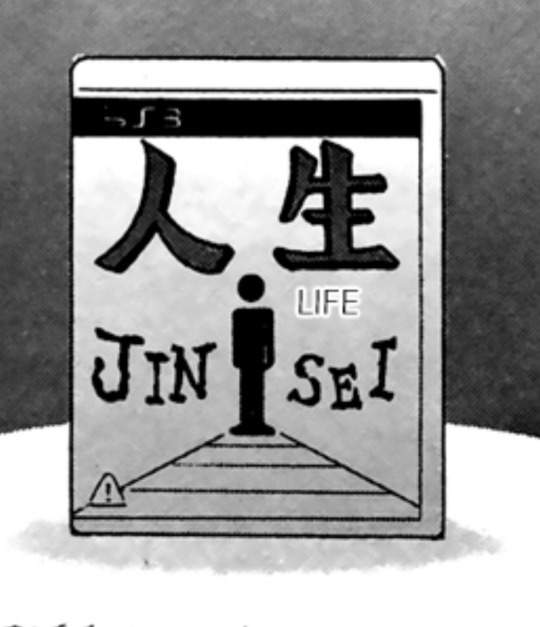
Ah… I get it. jinsei (人生)= life (person + life). I learned a new word… it’s N3 so I don’t feel that bad for not already knowing it, despite it being an incredibly basic one… Saiki, you really are a nerd, comparing life to rpg video games.

I like Saiki’s phrasing “it sounded like fun.” Life sounded like fun?
I wonder what the Japanese belief about souls before birth is. There’s not really much of one in Christianity. Hinduism and Buddhism both propose a life before birth as part of reincarnation. What is it here in the Saikiverse?
Personally, I kind of like the idea that a soul could have some fundamental interests and wants; more than that, curiosity. If souls exist. But I think they would have to be abstract things, like God and angels; things outside of our understanding while we are alive. I think this is the kind of thing that Toritsuka would know a lot about… maybe.
Okay that got off on a tangent.

Oh shit it’s this chapter! I totally forgot that this was in volume 1.

LMAO

Asou sensei… I am not sure how to feel about suicide being made funny. I guess: good? If you get a choice between laughing or crying, choose laughing… Nendou is such a pure soul, assuming that no one would want to end their own life on purpose.
Saiki won’t let him die <3 I am taking this as something sweet.

So… can Saiki hear people’s memories in these flashbacks? Or are they supposed to be fourth wall breaks? Both? I’m going with both. Rather than being like a movie, Saiki experiences flashbacks as though he were observing the person in the past (in other words, like he was really there.) That’s my take.

Also, Saiki has a ton of empathy. He just doesn’t show it. Like, this random guy (who ostensibly doesn’t have much going for him) tries to kill himself, and Saiki’s reaction is to compare his struggles in a way that makes sense to him; in video game terms. And he wants to save him and to help him. And he does.

Very mature of this random man, who a few hours ago was trying to fling himself off of a building, and a few minutes ago was talking about how he was too good for street performance. Had Nendou not intervened, I honestly don’t think he would have had the guts to do it…
Wow, I don’t know why this chapter is provoking my annoyance so bad. Hm. Well, maybe I do, but my Saiki k fan blog is no place for that.
In any case, it’s nice that Asou sensei gave this character a good ending (helped along by Saiki, of course.) Everyone deserves a chance to live a good life and do something that they enjoy. And being bad at something isn’t a crime. It’s just not a good idea to rely on income for something if you’re not that good at it (and not willing and/or able to work to get better.) Life lessons, I guess? Except it’s kind of undermined by Saiki. Which is a lesson in it of itself; sometimes fate intervenes and success comes regardless, I guess. Yeah, that’s an alright note to end on.

Another life lesson which is really profound— sometimes, all you need is one person to tell you that your work connected with them. Sometimes, that really is enough.

The only difficulty?? Saiki, you’re forgetting someone, aren’t you? A certain blue spiky haired, chihuahua sized someone who has a bold fake personality and a timid real one?

Aaaaand Saiki had turned this guy into Taylor Swift. fabulous.

Uh?? Translator error? He has 10 thousand copies, not ten million, right? Wait, why the hell am I wondering about this. I have the volume now and I can read Japanese numbers. let me check. Ok, it reads ハ… ハイ一万枚ありますから!(ha… hai ichi manmai arimasu kara!)

一万枚 (ichi manmai) = ten thousand.
ten million would be 千万 (sen man)
so yes, translation error. Translator probably got confused because 10 million yen is the amount of debt he has.
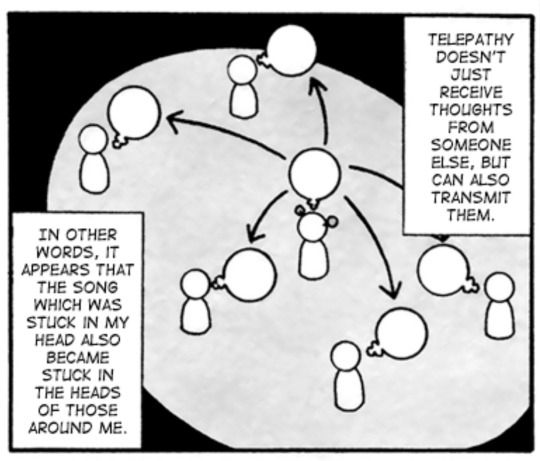
Honest to god this is one of the most fascinating tidbits about his powers and also an absolute crime that they left this out. I mean, I know why they did. But they should have stuck this detail about him projecting what’s stuck in his head somewhere in the anime, but they didn’t. It implies that to some degree Saiki’s telepathy isn’t always voluntary. And also that he doesn’t necessarily pick one person and beam thoughts into their heads. Hm. much to think about…

they were already discussing goods by the end of volume 1?! Well… Saiki k certainly did get merch in the end. I just wonder how much of it Asou sensei actually got money from, considering he didn’t get anything from the anime.
Alright, that concludes my review of the final chapter in this volume. Ja mata ne. end of 1-8💫
10 notes
·
View notes
Text
Book Review 2/48
The Signal and the Noise: Why so Many Predictions Fail - But Some Don't by Nate Silver
Good news is book #3 is shaping up to be better after a fairly mediocre start to the year.
This was published in 2012, making it 12 years old (horrifying.), and while usually I don't judge books for developments/discoveries since their publication...This is a book about predictions and forecasts, and Silver has made an immense name for himself on how good he is at predicting.
He got off on a bad start right away, talking reductively about the printing press (why?? I still have no idea) and his sources leave something to be desired--lots of news articles and popsci/pop history books, few research papers. But okay.
I read a lot of this snidely, which again, I do try to read in good faith. But it's simple errors like the below that make me get irritated with a book:
I then ordered the players by their skill level and broke them down into ten equal-size quadrants. The top quadrant—consisting of the top 10 percent of the player pool
This isn't the only one, just the one that bugged me the most.
Anyway, Silver's argument is we ought to use Bayesian statistics more in everyday life, which I don't disagree with, but his explanation and examples are...lacking. Everyone's favorite breast cancer false positives example makes an appearance, and he lays out the equation, and then just...moves on? Someone praised this book for being about statistics without including math; I agree that it does this but think it's a flaw.
Where the wheels really came off the wagon was in the chapter about predicting terrorist attacks; Silver argues that most nations have a fairly consistent (power law, not linear) relationship between # of terror attacks that cause a given # of fatalities, such that very high numbers of low casualty attacks can allow for the possibility of a future single attack with very high casualties. He then presents Israel as an outlier to this, because of how Israel conducts security.
...Right.
Again: 99% of the time I don't judge books based on later events because the author had no way of knowing; but if your entire book is about how good you personally are at assessing likelihood of events...
2/5
4 notes
·
View notes
Note
Good day, it's me again!
Got some questions for your Astralverse universe.
I tried scouring your blog for astralverse-tagged posts but didn't find sufficient answers so I figured I should present these questions.
It's mentioned in the doc that FTL travel is commonplace but FTL comms is only in experimental stage, by the looks of it. Which is weird in my mind because I thought it should be easier to solve FTL comms first. What's the in-universe lore/explanation for this?
Still on the topic of FTL technology, who's the primary user? Everyone in the Confed, just the founders, a handful of trusted races? And who was the first to kickstart the development for FTL? Is it before or after the Confed was formed?
How is currency handled between races? Is there a unified currency that everyone uses (a la present day European Union with EUR), or is currency exchange/conversion still required?
The flag for The Plex appears to be a flat grey rectangle. I thought it was a bug on my end but it's also displayed like that on desktop. Is that actually what their flag looks like? Or just a placeholder for now maybe?
This one isn't really a question but the Lamian Assembly is described as "society of semi-humanoid serpents" which I glossed over at first, but then clicked with something that I know of: the Lamia people in Elder Scrolls, who also resemble humanoid serpents. I don't know if that's where you took the name from or simply a mere coincidence, but I felt I wanted to bring that up.
Heya! Always happy to answer questions!
1. The specific method of FTL travel in the setting requires some manner of actual mass to work - sending information which has no mass was long thought impractically difficult. The Va'ruun's creators could do it, and consulting with the few of them that are left is how the experimental systems have come to be.
But until recently the method of "FTL" communication was just loading up a communication nano-satellite with messages, having it be carried by an FTL capable vessel into orbit of a given planet, and released, whereupon it transmits it messages to the surface. Not quite instantaneous communication, but decent enough. And importantly, it's fairly cost effective.
2. Everyone in the Confederation has FTL technology. FTL travel (like a lot of the more advanced technology in the setting, was originally a product of the same race that also created the Va'ruun.
The Va'ruun, after inheriting the creators' empire, and being a generous people, gave FTL to any species they befriended - which, when you are the Va'ruun, is extremely easy - any civilization is very likely to respond positively to them for any number of reasons.
3. There is indeed a common currency - the Confederation Unified Exchange note - the CUEnote. It exists both as physical currency (largely for governments, banking, and the like) and digital currency (for most average civilians). They are backed by the Confederation Central Reverse Bank, and derive value from both the largest reverse of physical precious metals in the known galaxy, and a significant reverse of physical member state currency.
Physical CUEnote designs are flat, plasticised sheets roughly 150 x 60 mm in size (roughly equivalent to a modern day US dollar). They exist in 1, 2, 5, 10, 20, 50, 100, 200, 500, 1000, 2000, 5000, and 10000 note varieties - though only notes up to 500 are in widespread circulation.
Regardless, individual member state currencies still exist, and are fully legal tender - conversion rates are calculated by the CCRB and change on a yearly basis. Currencies used by sub-states of member states are also accepted, especially when a member state is not an entirely unified government (to quote a famous Confederation economist: "The oft-cited 'most member states have 4.5 currencies' factoid is actually statistical error. Most member states have a single currency. The Terran Alliance, who lives in the Sol system and has over 180 currencies on one planet, is an outlier and should not have been counted. Please stop counting them, they're giving me nightmares.")
4. That is, in fact, their official flag! The Plex government insists, and has always maintained, that there is a "very beautiful design" adorning it.
Most people are convinced this is the Plex playing a species wide joke.
5. I took the name from more mythological sources there, but so did Elder Scrolls, so convergent evolution.
Ironically enough, the Lamia would actually be better described as "nagas", at least in a modern (furry) sense of the term.
They are, after all, essentially just the Vipers from XCOM:

11 notes
·
View notes
Text
“Voting is widely thought to be one of the most important things a person can do. But the reasons people give for why they vote (and why everyone else should too) are flawed, unconvincing, and sometimes even dangerous. The case for voting relies on factual errors, misunderstandings about the duties of citizenship, and overinflated perceptions of self-worth. There are some good reasons for some people to vote some of the time. But there are a lot more bad reasons to vote, and the bad ones are more popular.
(…)
In all of American history, a single vote has never determined the outcome of a presidential election. And there are precious few examples of any other elections decided by a single vote. A 2001 National Bureau of Economic Research paper by economists Casey Mulligan and Charles Hunter looked at 56,613 contested congressional and state legislative races dating back to 1898. Of the 40,000 state legislative elections they examined, encompassing about 1 billion votes cast, only seven were decided by a single vote (two were tied). A 1910 Buffalo contest was the lone single-vote victory in a century's worth of congressional races. In four of the 10 ultra-close campaigns flagged in the paper, further research by the authors turned up evidence that subsequent recounts unearthed margins larger than the official record initially suggested.
The numbers just get more ridiculous from there. In a 2012 Economic Inquiry article, Columbia University political scientist Andrew Gelman, statistician Nate Silver, and University of California, Berkeley, economist Aaron Edlin use poll results from the 2008 election cycle to calculate that the chance of a randomly selected vote determining the outcome of a presidential election is about one in 60 million. In a couple of key states, the chance that a random vote will be decisive creeps closer to one in 10 million, which drags voters into the dubious company of people gunning for the Mega-Lotto jackpot. The authors optimistically suggest that even with those terrible odds, you may still choose to vote because "the payoff is the chance to change national policy and improve (one hopes) the lives of hundreds of millions, compared to the alternative if the other candidate were to win." But how big does that payoff have to be to make voting worthwhile?
(…)
In their seminal 1993 book Decision and Democracy: The Pure Theory of Electoral Preference (Cambridge University Press), University of Virginia philosopher and reason Contributing Editor Loren Lomasky and his co-author, Geoffrey Brennan, offer an alternative theory of what drives voters. But first they offer a methodology for calculating the value of a vote. On their account, the expected utility of a vote is a function of the probability that the vote will be decisive, delivering gains (to the individual or society as a whole) if the preferred candidate wins. The probability of casting the decisive vote decreases slowly as the size of the voting pool gets larger, but it drops dramatically when polls show that one candidate has even a slight lead. Which means that in a presidential election, where the number of voters is about 120 million and one candidate is usually polling a point or two ahead on Election Day, you're screwed.
In his brilliant 2011 book The Ethics of Voting (Princeton University Press), on which I have relied heavily for this article, Georgetown University philosopher Jason Brennan (no relation to Geoffrey Brennan) applied the Lomasky/Brennan method to a hypothetical scenario in which the victory of one candidate would produce additional GDP growth of 0.25 percent in one year. Assuming a very close election where that candidate is leading in the polls only slightly and a random voter has a 50.5 percent chance of casting a ballot for her, the expected value of a vote for that candidate is $4.77 x 10 to the ?2,650th power. That's 2,648 orders of magnitude less than a penny.
(…)
Those figures reflect 2006 GDP figures and 2004 voting totals, but it almost doesn't matter what batch of reasonable numbers you plug into the equation. Say you think victory is worth 10 or 100 or 1,000 times more than the roughly $33 billion that 0.25 percent of GDP amounts to. Say the polls show a gap of two percentage points between the candidates. In any plausible scenario, the expected utility of your vote still amounts to approximately bupkes. A vote for a third-party candidate pushes the figure into even more infinitesimal territory.
(…)
In October 2000, Harvard economist Gregory Mankiw penned a column for Fortune called "Why Some People Shouldn't Vote." During his years-long stint as a columnist for the magazine, this was the only article the editors refused to run. The column, which he published on his personal blog years later, suggests that "the next time a friend of yours tells you he's not voting, don't try to change his mind."
Mankiw's argument draws on a 1996 article by economists Timothy Feddersen of Northwestern University and Wolfgang Pesendorfer of Princeton University that cites the phenomenon of "roll off"—people who make it all the way inside the polyester curtains on Election Day and then leave some blanks on their ballots—to illustrate the point that people who believe themselves ill-informed routinely choose not to vote, thereby increasing the quality of voters who actually pull the lever for one side or the other. There is some additional evidence for this claim: Education is one of the two best predictors of voter turnout (the other is age). Better-educated people are much more likely to vote, which suggests that the pool of voters is better informed and more qualified to make election-related judgments than the pool of nonvoters.
"A classic argument for why democracies need widespread public education is that education makes people better voters," Mankiw writes. "If this is true, then the less educated should show up at the polls less often. They are rationally delegating the decision to their better educated neighbors."
What Mankiw doesn't go on to say, perhaps because he fears insulting his readers, is that people aren't particularly good at knowing whether or not they are well-informed. Many people who follow politics closely hold views that are dangerous and wrong (see George Mason University economist Bryan Caplan's October 2007 reason cover story "The 4 Boneheaded Biases of Stupid Voters"). Even if everyone who had the slightest suspicion that he was not knowledgeable enough to vote stayed home on Election Day, millions of people would still be casting ill-informed votes.
(…)
Encouraging more ignorant people to vote is not just pointless, argues Jason Brennan; it's morally wrong. There is no duty to vote, but many people may have a duty not to vote. Boosting turnout among citizens who are young, uneducated, or otherwise less likely to be engaged—the primary targets of get-out-the-vote campaigns—is likely to have the unintended consequence of encouraging people to fail in that duty.
To explain why we might worry about casting an uninformed vote even when no particular vote is likely to be decisive, Brennan conjures this terrifying thought experiment: Imagine you come across a firing squad about to kill an innocent child. Assume all the bullets will strike at the same time and that there's nothing you can do to stop them. You are invited to be the 101st member of the squad. What do you say? Brennan posits a framework to deal with this kind of hypothetical, the "clean hands principle," which states that "one should not participate in collectively harmful activities when the cost of refraining from such activities is low."
None of this is to suggest that the government should test voters or use some other legal means to limit voting. Instead, this is a private moral concern for each voter. If you believe your vote is likely to be ill-informed or that a particular race is likely to yield an unfair, unjust, or otherwise bad outcome, you should refrain from participating in a collectively harmful activity, thus keeping your hands clean. Get-out-the-vote campaigns promote precisely the kind of morally condemnable ignorant voting we should be discouraging.
(…)
In his 1851 book Social Statics, the English radical Herbert Spencer neatly describes the rhetorical jujitsu surrounding voting, consent, and complaint, then demolishes the argument. Say a man votes and his candidate wins. The voter is then "understood to have assented" to the acts of his representative. But what if he voted for the other guy? Well, then, the argument goes, "by taking part in such an election, he tacitly agreed to abide by the decision of the majority." And what if he abstained? "Why then he cannot justly complain…seeing that he made no protest." Spencer tidily sums up: "Curiously enough, it seems that he gave his consent in whatever way he acted—whether he said yes, whether he said no, or whether he remained neuter! A rather awkward doctrine this." Indeed.
(…)
Ah, now we're getting somewhere. Maybe people vote not because of what voting can accomplish, but because they like to vote. They like the message that voting sends about who they are (e.g., the kind of person who cares about poverty, or fiscal responsibility, or what his neighbors think).
Many people like to be perceived as altruists, for example. Voting is one of the cheapest forms of altruism. If you (rightly) believe that the expected material payoff of your vote is near zero, then it's easy enough to vote in a way that maximizes your halo rather than your bottom line. "Voting sociotropically," Jason Brennan writes, "is cheaper and easier than volunteering at a soup kitchen or giving money to Oxfam."
A 2009 survey of 569 professors conducted by philosophers Eric Schwitzgebel of the University of California at Riverside and Josh Rust of Stetson University reinforces this view: 88 percent said they considered voting in public elections to be morally good. In fact, when asked to rank different acts, the professors reported that they considered voting to be on par with regularly donating blood and giving 10 percent of one's income to charity.
Loren Lomasky and Geoffrey Brennan theorize that voting is best understood as an expressive act. Communicating preferences at the ballot box is something people do for its own sake, not a duty they perform or a selfish bid for material gain.
(…)
Bryan Caplan takes the idea a step further. Perhaps, he suggests, voting is more like cheering while watching the same game from your recliner in a darkened living room. If you really try, you can still tell an (ultimately unsatisfying) story about why your actions matter in the rest of the world. After all, your viewership of the game might show up in the television ratings, which boosts the team's advertising revenue. Of course, you're probably not a Nielsen household, so you may not show up at all in the metrics that the team's owners can see. Which leaves solitary game watchers right there with the voters: The main payoff is that you can show up at work the next day and say you did it.
So what's wrong with that? Individual cases of expressive voting in large elections are just as unlikely to affect the outcome of the election as other kinds of voting. But the fact of widespread expressive voting explains why elections are silly season. Politicians offer themselves up as opportunities for expressive voting, as aggregations of easily comprehensible slogans rather than as avatars of sensible policy. Ignorant expressive voters, even rationally ignorant ones, may be committing immoral acts, as Jason Brennan argues.
All of which is a pretty steep price for an "I Voted" sticker.”
“The choice in the elections is between corporate and oligarchic power. Corporate power needs stability and a technocratic government. Oligarchic power thrives on chaos and, as Steve Bannon says, the “deconstruction of the administrative state.” Neither are democratic. They have each bought up the political class, the academy and the press. Both are forms of exploitation that impoverish and disempower the public. Both funnel money upwards into the hands of the billionaire class. Both dismantle regulations, destroy labor unions, gut government services in the name of austerity, privatize every aspect of American society, from utilities to schools, perpetuate permanent wars, including the genocide in Gaza, and neuter a media that should, if it was not controlled by corporations and the rich, investigate their pillage and corruption. Both forms of capitalism disembowel the country, but they do it with different tools and have different goals.
Kamala Harris, anointed by the richest Democratic Party donors without receiving a single primary vote, is the face of corporate power. Donald Trump is the buffoonish mascot for the oligarchs. This is the split within the ruling class. It is a civil war within capitalism played out on the political stage. The public is little more than a prop in an election where neither party will advance their interests or protect their rights.
George Monbiot and Peter Hutchison in their book “Invisible Doctrine: The Secret History of Neoliberalism,” refer to corporate power as “housebroken capitalism.” Housebroken capitalists need consistent government policies and fixed trade agreements because they have made investments that take time, sometimes years, to mature. Manufacturing and agriculture industries are examples of “housebroken capitalism.”
(…)
Monbiot and Hutchison refer to oligarchic power as “warlord capitalism.” Warlord capitalism seeks the total eradication of all impediments to the accumulation of profits including regulations, laws and taxes. It makes its money by charging rent, by erecting toll booths to every service we need to survive and collecting exorbitant fees.
The political champions of warlord capitalism are the demagogues of the far right, including Trump, Boris Johnson, Giorgia Meloni, Narendra Modi, Victor Orban and Marine Le Pen. They sow dissension by peddling absurdities, such as the great replacement theory, and dismantling structures that provide stability, such as the European Union. This creates uncertainty, fear and insecurity. Those that orchestrate this insecurity promise, if we surrender even more rights and civil liberties, that they will save us from phantom enemies, such as immigrants, Muslims and other demonized groups.
The epicenters of warlord capitalism are private equity firms. Private equity firms such as Apollo, Blackstone, the Carlyle Group and Kohlberg Kravis Roberts, buy up and plunder businesses. They pile on debt. They refuse to reinvest. They slash staff. They willfully drive companies into bankruptcy. The object is not to sustain businesses but to harvest them for assets, to make short-term profit. Those who run these firms, such as Leon Black, Henry Kravis, Stephen Schwarzman and David Rubenstein, have amassed personal fortunes in the billions of dollars.
(…)
The wreckage private equity firms and the oligarchs orchestrate, is taken out on workers who are forced into a gig economy and who have seen stable salaries and benefits eradicated. It is taken out on pension funds that are depleted because of usurious fees, or are abolished. It is taken out on our health and safety. Residents of nursing homes, for example, owned by private equity firms, experience 10 percent more deaths — not to mention higher fees — because of staffing shortages and reduced compliance with standards of care.
Private equity firms are an invasive species. They are also ubiquitous. They have acquired educational institutions, utility companies, and retail chains, while bleeding taxpayers hundreds of billions in subsidies which are made possible by bought-and-paid-for prosecutors, politicians, and regulators. What is particularly galling is that many of the industries seized by private equity firms — water, sanitation, electrical grids, hospitals — were paid for out of public funds. They cannibalize the nation, leaving behind shuttered and bankrupt industries.
(…)
The housebroken capitalists are represented by politicians such as Joe Biden, Kamala Harris, Barack Obama, Keir Starmer and Emmanuel Macron. But “housebroken capitalism” is no less destructive. It pushed through the North American Free Trade Agreement (NAFTA), the greatest betrayal of the American working class since the 1947 Taft-Hartley Act, which placed crippling restrictions on union organizing. It revoked the Banking Act of 1933 (Glass-Steagall) which separated commercial banking from investment banking. Tearing down the firewall between commercial and investment banks led to the global financial meltdown in 2007 and 2008, including the collapse of nearly 500 banks. It pushed through the elimination of the Fairness Doctrine by the Federal Communications Commission under Ronald Reagan as well as the Telecommunications Act under Bill Clinton’s presidency, allowing a handful of corporations to consolidate control of media outlets. It destroyed the old welfare system, 70 percent of the recipients of whom were children. It doubled our prison population and militarized the police. In the process of moving manufacturing to countries such as Mexico, Bangladesh and China, where workers toil in sweatshops, 30 million Americans were subjected to mass layoffs according to figures compiled by the Labor Institute. Meanwhile, it piled up massive deficits — the federal budget deficit rose to $1.8 trillion in 2024, with total national debt approaching $36 trillion — and neglected our basic infrastructure, including electrical grids, roads, bridges and public transportation, while spending more on our military than all the other major powers on Earth combined.
These two forms of capitalism are species of totalitarian capitalism, or what the political philosopher Sheldon Wolin calls “inverted totalitarianism.” In each form of capitalism, democratic rights are abolished. The public is under constant surveillance. Labor unions are dismantled or defanged. The media serves the powerful and dissident voices are silenced or criminalized. Everything is commoditized from the natural world to our relationships. Grassroots and popular movements are outlawed. The ecocide continues. Politics is burlesque.
(…)
The Weimarization of the American working class is by design. It is about creating a world of masters and serfs, of empowered oligarchic and corporate elites and a disempowered public. And it is not only our wealth that is taken from us. It is our liberty. The so-called self-regulating market, as the economist Karl Polanyi writes in “The Great Transformation,” always ends with mafia capitalism and a mafia political system. A system of self-regulation, Polanyi warns, leads to “the demolition of society.”
If you vote for Harris or Trump — I have no intention of voting for any candidate who sustains the genocide in Gaza — you are voting for one form of rapacious capitalism over another. All the other issues, from gun rights to abortion, are tangential and used to distract the public from the civil war within capitalism. The tiny circle of power these two forms of capitalism embody, exclude the public. These are elite clubs, clubs where wealthy members inhabit each side of the divide, or at times go back and forth, but are impenetrable to outsiders.
The irony is that the unchecked greed of the corporatists, the housebroken capitalists, created a small number of billionaires who became their nemesis, the warlord capitalists. If the pillage is not halted, if we do not restore through popular movements control over the economy and the political system, then warlord capitalism will triumph. The warlord capitalists will cement into place neo-feudalism, while the public is distracted and divided by the antics of killer clowns like Trump.
I see nothing on the horizon to avoid this fate.
Trump, for now, is the figurehead of warlord capitalism. But he did not create it, does not control it and can easily be replaced. Harris, whose nonsensical ramblings can make Biden look focused and coherent, is the vacuous, empty suit the technocrats adore.
Pick your poison. Destruction by corporate power or destruction by oligarchy. The end result is the same. That is what the two ruling parties offer in November. Nothing else.”
“Yet, 79 years after he killed himself in a Berlin bunker, more than one in 10 (11 percent) of Americans believe the barbaric German tyrant leader had some 'good ideas'.
A DailyMail.com/J.L. Partners poll found that more than one in five (21 percent) of both Gen Z and black voters and 19 percent of Hispanic voters agreed with the statement.
The survey asked 1,000 likely voters whether they think Hitler had some 'good ideas' or if he was 'evil and had no redeeming features.'
77 percent said he was 'evil', 12 said they were 'unsure' and a surprising 11 percent believe he had some redeeming qualities.
When broken down by age group, 21 percent of those under the age of 29 said Hitler had good ideas, compared with 16 percent of those between the ages of 30 and 49, seven percent for voters between 50 and 64 and just five percent for those over 65.
Fourteen percent of Donald Trump supporters said Hitler had some positive aspects, compared to nine percent of Kamala Harris.
'If you need an example of the corrosive impact that social media can have on younger Americans' view of the world, this is it,' James Johnson, founder of J.L. Partners, told DailyMail.com of the startling results.
(…)
Earlier this month, TikTok was forced to remove AI-generated and translated videos of Hitler's speeches that had racked up more than one million views.
(…)

A Pew Research poll (https://www.pewresearch.org/religion/2020/01/22/what-americans-know-about-the-holocaust/) in 2020 found that while half of U.S. adults knew what the Holocaust was and when it happened, but less than 50 percent could answer how many Jews were killed and when Hitler came to power.
In December, a DailyMail.com found that one in five young Americans had a positive view of 9/11 mastermind and Al Qaeda founder Osama Bin Laden.
The alarming survey also found three in 10 Gen Z voters believe the views of the anti-Semitic terrorist leader who slaughtered thousands of innocent people were a ‘force for good'.
(…)
Another DailyMail.com poll from October 2023 found one in 10 voters under the age of 30 had a positive view of Hamas, despite the group's murderous attack on Israel that killed more than 1,300 men, women and children.”
2 notes
·
View notes
Text
{One of the JJBA wikis has some... inaccurate information, and for a fleeting moment, I lived in a reality where Illuso was taller than Risotto.}
{It was not a particularly good reality. The only reason I even checked the source that the wiki provided was because I was simply so fucking indignant at the suggestion that Risotto, famously titanic in size, was shorter than Illuso.}
{The source itself is a height comparison reference sheet for the anime, containing every La Squadra member save Sorbet and Gelato, (and Giorno Giovanna because he's the main character), with a numbered height chart. The problem is the source contradicts itself, as Risotto is labelled as 185 cm at the bottom, (what the page has listed) resulting in an understatement of Risotto Nero's height by approximately 10 centimetres, as he is clearly drawn such that the top of his head (it's obvious that his jester-hat-in-hood-form adds no height and simply drapes over his head, so there's no need to account for it and no height disparity) is situated precisely on the height line for 195 centimetres, and that's even with his head slightly bowed; so he might even be slightly taller but I'll let it slide.
And even once I had determined this error, I still find myself in a reality where Illuso is over 6' (188 centimetres to be precise) which, absolutely fucking not; that is far too fucking tall for Illuso, and for what? For what purpose does he even need to be tall? I would have never for a moment considered that he exceeded, say, 5'9" (175.26 cm), perhaps. He is of such incredibly average stature in my mind. And Pesci is only 5'5"? Really? He's the shortest? I'm not too terribly sure why but I was under the impression that he was much taller. Like, if I'd gone on the wiki and read that Pesci was, like, 6'0"? I would've believed that rather easily. Aside from him, (unless Sorbet or Gelato are shorter than 171 cm) Ghiaccio is the shortest, and, yeah, that tracks. I could maybe see Gelato as short as 5'0".}
{In other related news, Zatta in her heels is just about 4 centimetres (roughly an inch) away from being as tall as Risotto, and without her heels, she's dwarfed by the entire team, being approximately 8 centimetres (about 3 inches) shorter than Pesci (supposedly is). No wonder her heels are so ridiculous. I'm envisioning the 'how to talk to short people' meme. (Information's accuracy no longer certain).}
#jjba original character#jjba oc#jjba part 5#part 5#vento aureo#il vento d'oro#golden wind#la squadra esecuzioni#la squadra#la squadra di esecuzione#risotto nero#illuso#ghiaccio#pesci#Ilta puhuu
39 notes
·
View notes